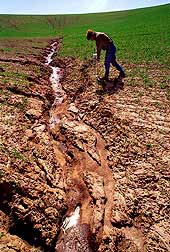|
Sheet And Rill Erosion

During heavy rain, erosion of exposed surface soil can occur
even on quite gentle slopes. The process often follows this
sequence:
• Raindrop or splash erosion breaks the soil structure
allowing smaller particles to clog soil pores and seal the
surface.
• Sheet erosion follows as the constant agitation keeps
fine soil particles in suspension allowing them to move off-site
with the water.
• Rill erosion leaves fine channels as water concentrates
into fast flowing streams that begin to gouge out the surface
soils.
This process has been represented in the Universal Soil Loss
Equation (ULSE):
Soil loss = R x ST x S x L x C x T
Where:
SL is Soil Loss
R is the erosivity of the Rain (duration, intensity etc)
ST is the Soil Type (structure, organic mater content, etc)
S is the Slope
L is the Length of the unprotected slope
C is the Crop type or vegetation cover
T is the Tillage method
Whilst the accuracy of the USLE has been shown to vary, it
is clear the factors listed above do provide guidance as to
how farmers can reduce risk. Farmers can reduce soil erosion
by retaining vegetative cover and through careful management
of soil structure. It also possible in some circumstances
to even change slope characteristics. Although terracing of
slopes is a common practice in some tropical countries, it
is unlikely to be practical on many Australian farms. There
is however, an opportunity to break up long slopes using soil-banks,
grass banks or even belts of trees, thereby reducing the effective
slope length.
Research trials in tropical environments in Queensland and
overseas have demonstrated that belts of shrubs planted along
a contour can significantly reduce soil loss by water erosion
on slopes. In extreme examples the build up of soil behind
the belt can be dramatic (see photo). In this case belts of
nitrogen fixing fodder trees have been planted. Following
heavy rain, soil washed from the slopes is captured and retained
by the belt resulting in a natural terracing effect.
Back to top
|
